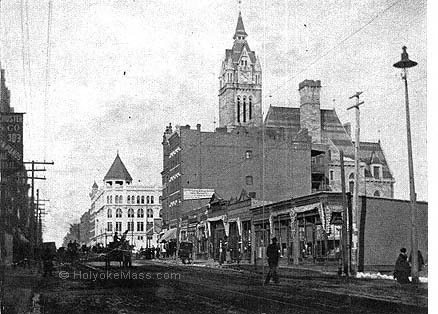|
Some distance below the present iron bridge, was a ferry. In former times the boat had been poled across the stream, but latterly a stone wharf had been built in mid-river, a little above the ferry, and a tale pole erected on it. From the top of this was strung a long wire, to which the boat was attached, and, by adjusting the boat diagonally to the current, the swift water carried it across. The wharf yet holds its stand in mid-stream, a little below the new bridge. For years its tall sentinel pole stood stiffly erect on the little island, but like all things prominent and unprotected this was a temptation to the boys, who built fires around its base, and brought it down.
The City Hall
There is still a charred stub left, and in its company a sturdy little elm has started to grow. If ice jams and boys will spare this, it will make a very pretty feature out there in the stream some day.
In the early days the boat only carried an occasional team, but later, by reason of Holyoke’s rapid growth,
|
Looking Towards the city Hall from Hampden Park.
it became one of the busiest ferries on the river, and this ferry—right in its last years—was one of the most valuable pieces of property in the whole region. For the last few seasons before the bridge was built, lines of teams would be waiting on wither side to cross a good deal of the time. The boat ran all winter, as the current was swift enough here to prevent freezing ordinarily.
On the rare occasions that ice did form, the river could be crossed down stream a few miles, or after the dam was built, it was always good crossing at such times on the ice above it.
Among the other craft on the river was the "Bill Hall," a flat-bottomed, stern-wheel steamboat eighty or one hundred feet long, used it towing boats up from Hartford. The "Bill Hall" had John Mulligan, now president of the Connecticut River Railroad, for its engineer and captain. After a service of fifteen or twenty years the railroad was built, and the boat’s usefulness was then practically ended.
Connected with the ferry is the following bit of romance:—A young man from Chicopee, who was in the habit of calling on a South Hadley Falls young woman, found it convenient to cross here frequently. But one evening, having received a negative answer to a certain important question, he came down to the ferry and sat on the edge of the boat, looking quite dejected. Then of a sudden there was a splash, and the startled ferryman noted the unfortunate young man had gone over backwards into the water.
|

Left: The Business Center
|
They made haste to fish him out, and he being half-drowned, the question was what to do with him. Now the ferryman knew at which house it was his habit to call, but did not know the circumstances of his last leaving it. They therefore bore their unconscious charge thither. Between the tragic facts of the case, the neighbors and the doctors who came to assist, there was great excitement. The sequel is of the kind one finds in novels more often than in real life. The man lay there in the house sick for some time, his mother came to nurse him, and, last but not least, the young lady in the case repented her former decision and changed it to a "yes."
At the landing on the Holyoke side was a little ferry shanty, and just above it a "shad-house." The latter was owned by the fish company, and in it the stored their net, boat, oars, etc. In one corner was a rude bar and a long, cast-iron wood stove. Here Chester W. Chapin presided for some years during the fishing season, selling flip and cheap cigars to such of the crowds which resorted thither as felt the need of refreshment. Mr. Chapin was then a tall, slim, smooth-faced young man, quick, good natured and energetic. He employed his winters in teaching school, and in the spring invested in a puncheon of rum and made his headquarters at the Holyoke fish house. A little later he engaged in driving one of the valley stages, and presently became one of the owners of the route. Afterward he was interested in the river passenger business below Springfield, and in his last years was one of the New England Railroad magnates, When he died he was the richest man in western Massachusetts.
© Laurel O’Donnell 1996 - 2006, all rights reserved
This document may be downloaded for personal non-commercial use only
and may not be reproduced or distributed without permission in any format.
This is an edited adaptation from the original publication.
|
|
|